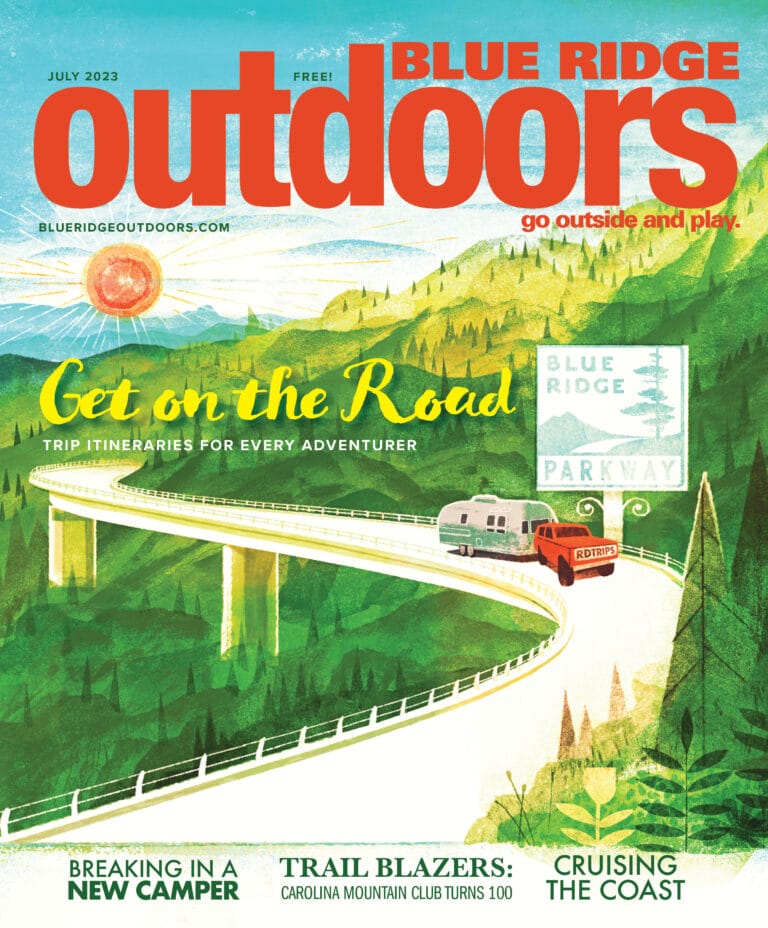Bicycle commuters who get to work without the gas.
In the car-clogged United States, cities have been designed to accommodate motor vehicles, with most other forms of transit pushed to the shoulder. But that hasn’t stopped one Asheville cyclist from following a 100% pedal-powered lifestyle. Tavis Cummings grew up outside of a small town in rural Iowa, where both he and his younger brother, Stiles, regularly walked, ran, or rode their bikes eight miles round-trip to school or town. The Cummings brothers became top cyclists and bike enthusiasts in the region.
Their father, Gary, was one reason for their success. He managed a bike shop 40 miles from their home and often rode there and back each day. His example helped the boys view bicycling as more than just sport.

“He opened my eyes to bicycling as a viable mode of transport, “ says Tavis. “I realized that the commute itself could be an athletic event.”
When his father and brother moved to Asheville, N.C., Tavis followed them there and opened his own massage therapy studio. Then Stiles died suddenly in 2006. Tavis decided to honor his brother the best way he knew how: by riding his bike. He outfitted Stiles’ mid-80s Bianchi steel-frame with a rack, panniers, fenders, an array of lights, and he began commuting everywhere with it. Eventually he sold his car, and for two years, he has been traveling by bike, including 20 miles round-trip to his massage studio each day.
Through blizzards and thunderstorms, the 33-year-old pedals to the laundromat, the grocery store, and even his girlfriend’s house seven miles away.
“Even though bicycle commuting is a seemingly small step, I’m part of a bigger movement that’s working for change by being the change,” says Tavis. He shared his thoughts with BRO on the greatest challenges and rewards of his car-free lifestyle.
Why go through all the hassle of commuting by bicycle?
My motives are purely selfish: I love being able to propel myself. Bicycle commuting improves the health of my entire being. The self-reliance and freedom from automobile dependency also feel good. Commuting is also an athletic event. Instead of working out at the gym at the end of the day, my commute is my workout.
How do you handle sweatiness?
When riding, I wear lightweight clothes which breathe and dry quickly. I keep clean clothes at work, and I allow extra time for cool down after the ride. I installed a shower at my studio, but a quick rinse in the sink with soap and cold water will also take care of any sweatiness or odor.
How do you stay motivated to ride in miserable weather?
It’s really not as bad as it seems, especially if you are dressed properly. The miles disappear pretty quickly under bicycle wheels. When it’s particularly tough weather, I repeat my brother Stiles’ mantra: “Keep going till you get there.”
What are the biggest challenges of living car-free?
A lot more time is spent planning and preparing for trips into town. Unlike a car, I am physically responsible for everything I carry, so I’m especially attentive to the weight of things. Impulse shopping is a thing of the past. My clothing tends to be layered and multifunctional. And I pay more attention to the weather. It’s actually quite exciting for the weather and the seasons to matter again in my everyday life. I feel reconnected to what’s important.
Riding through one of the worst winters on record, I never missed a day of work because of my commute. This is your choice, I would remind myself. You just gotta find a way to do it.
What’s the best part about bicycle commuting?
Interacting with the community. I don’t enjoy being in a car breathing recycled air, cut off from the people all around me. On my bike, I am always happy. And I can talk to people on sidewalks and around town without having to roll down my window.
What better way to invest yourself in what you’re doing than to get yourself there under your own power? When I visit friends, they know I have invested my time and energy to be with them.
There are also the unseen costs of owning and maintaining a car, including insurance, gas, and the time spent working just to pay for a car. It didn’t add up for me. I’d rather spend that time and effort on my bike. It was a lifestyle adjustment at first, but I truly don’t miss my car anymore.
Not having a car around has some other surprising benefits. My driveway is now a huge patio, and a garage can accommodate more storage space without a car parked in it.
Are you concerned about the dangers?
I have never had a collision with a car, and I attribute that to being very visible and riding responsibly. If you ride respectfully, most drivers will do the same. Know and follow traffic laws so we as cyclists avoid creating animosity and giving ammunition to motorists who already don’t like cyclists. Bicycle commuting isn’t just about getting somewhere. It’s important to enjoy the ride. You are far safer—and happier—if you ride casually and carefully.
Do you ever get angry with motorists who drive too close or yell?
There have been times when I have felt like a target. Bikes are definitely at a disadvantage in terms of size and speed, but we have an equal right to use the road. If we want any real change in the public’s eye, we have to ignore motorist road rage and resist responding negatively to it. I try to stay focused on the positive experiences of my own ride, especially when interacting with motorists. Waving, smiling, and making eye contact are especially helpful. 99 percent of drivers out there are accommodating.
Isn’t bicycle commuting just making your life unnecessarily difficult?
I’ve never been interested in the easy road, but bicycle commuting has gotten easier—both physically and mentally—the more I do it. And I can help bring about positive change through example. Changes in politics, infrastructure, and attitudes tend to take a while. But I can start right now with my day-to-day life by showing others how fun and fulfilling bicycle commuting can be—and practical, too. •
TAVIS’ TIPS
be educated
Know your state and local traffic laws, especially pertaining to bikes. North Carolina and Virginia laws require motorists to provide two feet of roadway to cyclists at all times.
be visible
Wear brightly colored clothing and make sure your bicycle is equipped with front and rear lights. Reflective tape on your helmet and bike frame is also highly recommended.
be responsible
Stop at traffic lights and signs, just like other vehicles. Use arm signals to indicate turns. Be a defensive rider and anticipate motorists’ errors. Most importantly, be a positive example for the cycling community.
be prepared
Wear layers of clothing in winter, especially covering the hands. In wet weather, fenders keep water from spraying off bicycle tires.

FUN BETWEEN YOUR LEGS
Car-free commuter and bicycle activist Michael Sule
Michael Sule hasn’t owned a car in four years, and he wants others to join him in the bike lanes. To corral a growing scene of urban cyclists, the sixth-grade teacher founded Asheville on Bikes—it’s Critical Mass with a festive attitude, and it’s working. Through costumed rides like Bike of the Irish and the micro-brew-fueled throwdown Bike Love, the bike bashes have gained a loyal following. His rides now attract hundreds of cyclists, and he’s raised enough funds to put in a downtown bike locker and start bike safety classes. He’s also helping the city implement a plan to expand commuter lanes.
How do the good times translate into action?
Riding bikes through a city is fun. If you show people a good time, they’re going to respond and get involved. Asheville on Bikes tries to keep a good balance between celebrating bike culture and using it as a mechanism to get better infrastructure.
Is it working?
At our events, we have kids, novices, and elite Spandex-clad cyclists riding together. We’ve also attracted politicans and local leaders to our events. As a result, bicycle infrastructure is gaining traction.
How do you address commuter safety concerns?
We send volunteers into driver’s education classes to teach young drivers about interacting with cyclists. I hope to take it a step further by having kids take alternative transportation classes, so they learn how to change bike tires and read a bus map.
Best thing about ditching your car?
I saved $10,000 the first year I gave up my car. It also improved my health and fitness, because I started eating better and using my body more. I was also able to afford to live downtown. My life has been primarily concentrated on where I can walk and ride. I’m unable to drive out to a big box store, so for the first time I am living local.
TAVIS ’ GEAR
BIKE
I have an array of reflectors and lights all over my bike. I’ve found that the more visible I am, the more I’m taken seriously by motorists and the more space they allow. Knowing that I’m extremely visible helps me ride comfortably. I have a rack with two panniers that can each hold 30 pounds total of laundry and groceries. And I have fenders over the wheels to prevent water splashing in wet weather. In harsh winter weather, I prefer riding a singlespeed because of the drive train’s durability. A bike with a derailleur can get clogged more easily with snow and slush. But most of the year I ride a bike with gears and large-diameter road bike tires because the skinny tires are more efficient on the pavement. Any kind of bicycle can be used for commuting. It doesn’t require a special bike. clothing I always wear highly visible clothing and dress in layers. In severe winter weather, I wear ski goggles and ski gloves with Windstopper liners that wick away moisture, and a waterproof GoreTex shell. Summer riding can be just as tough with the dangers of sun exposure and dehydration.
Check out Tavis’ commuting gear and bike, and watch a video from this year’s Bike Love HERE.







